国际经济学作业答案第二章
- 格式:pdf
- 大小:12.82 KB
- 文档页数:7
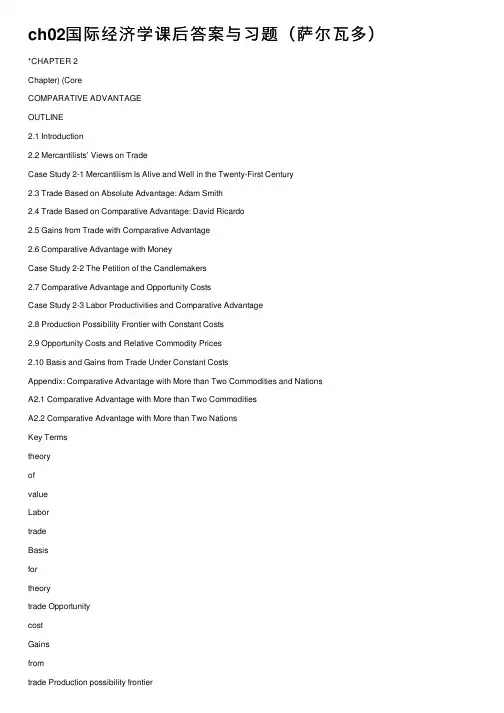
ch02国际经济学课后答案与习题(萨尔⽡多)*CHAPTER 2Chapter) (CoreCOMPARATIVE ADVANTAGEOUTLINE2.1 Introduction2.2 Mercantilists’ Views on TradeCase Study 2-1 Mercantilism Is Alive and Well in the Twenty-First Century2.3 Trade Based on Absolute Advantage: Adam Smith2.4 Trade Based on Comparative Advantage: David Ricardo2.5 Gains from Trade with Comparative Advantage2.6 Comparative Advantage with MoneyCase Study 2-2 The Petition of the Candlemakers2.7 Comparative Advantage and Opportunity CostsCase Study 2-3 Labor Productivities and Comparative Advantage2.8 Production Possibility Frontier with Constant Costs2.9 Opportunity Costs and Relative Commodity Prices2.10 Basis and Gains from Trade Under Constant CostsAppendix: Comparative Advantage with More than Two Commodities and NationsA2.1 Comparative Advantage with More than Two CommoditiesA2.2 Comparative Advantage with More than Two NationsKey TermstheoryofvalueLabortradeBasisfortheorytrade OpportunitycostGainsfromtrade Production possibility frontierofPatterncostopportunityConstantMercantilismcommodityRelativeprices advantageAbsolutespecializationCompleteLaissez-faireLaw of comparative advantage Small-country case-7-Lecture Guide1. This is a long and crucial core chapter and may require four classes to cover adequately. In thefirst lecture, I would present Sections 1-4 and assign review questions 1-3.2. In the second lecture of Chapter 2, I would concentrate on Sections 5-6 and carefully explain the law of comparative advantage using simple numerical examples, as in the text. Both sections are crucial. Section 5 explains the law of comparative advantage and Section 6 establishes the link between trade theory and international finance. I find that the numerical explanations before the graphical analysis really helps the student to truly understand the law. The simple lawyer-secretary example should also render the law more immediately relevant to the student. I would also assign Problems 4-7.3. In the third lecture, I would cover Sections 7-9 and assign Problems 8-10.4. In the fourth lecture, I would Section 10 and go over problems 4-10. The appendixes could bemade optional for the more enterprising students in the class.Answer to Review Questions and Problems1. The mercantilists believed that the way for a nation to become rich and powerful was toexport more than it imported. The resulting export surplus would then be settled by an inflow of gold and silver and the more gold and silver a nation had, the richer and more powerful it was. Thus, the government had to do all in its power to stimulate the nation’s exports and discourage and restrict imports. However, since all nations could not simultaneously have an export surplus and the amount of gold and silver was fixed at any particular point in time, one nation could gain only at the expense of other nations. The mercantilists thus preached economic nationalism, believing that national interests were basically in conflict.Adam Smith, on the other hand, believed that free trade would make all nations better off.All of this is relevant today because many of the arguments made in favor of restrictinginternational trade to protect domestic jobs are very similar to the mercantilists argumentsmade three or four centuries ago. That is why we can say that “mercantilism is alive and well in the twenty-first century”. Thus we have to be prepared to answer and demonstrate thatthese arguments are basically wrong.2. According to Adam Smith, the basis for trade was absolute advantage, or one country being more productive or efficient in the production of some commodities and other countriesbeing more productive in the production of other commodities.The gains from trade arise as each country specialized in the production of the commodities in which it had an absolute advantage and importing those commodities in which the nation had an absolute disadvantage.Adam Smith believed in free trade and laissez-faire, or as little government interference with the economic system as possible. There were to be only a few exceptions to this policy of laissez-faire and free trade. One of these was the protection of industries important for national defense.3. Ricardo’s law of comparative advantage is superior to Smith’s theory of absolute advantage inthat it showed that even if a nation is less efficient than or has an absolute disadvantage in theproduction of all commodities with respect to the other nations, there is still a basis for beneficial trade for all nations.The gains from trade arise from the increased production of all commodities that arises wheneach country specializes in the production of and exports the commodities of its comparativeadvantage and imports the other commodities.A nation that is less efficient than others will be able to export the commodities of its compara-tive advantage by having its wages and other costs sufficiently lower than in other nations so asto make the commodities of its comparative advantage cheaper in terms of the same currencywith respect to the other nations.4. a. In case A, the United States has an absolute and a comparative advantage in wheat and theUnited Kingdom in cloth.In case B, the United States has an absolute advantage (so that the United Kingdom has anabsolute disadvantage) in both commodities.In case C, the United States has an absolute advantage in wheat but has neither an absoluteadvantage nor disadvantage in cloth.In case D, the United States has an absolute advantage over the United Kingdom in bothcommodities.b. In case A, the United States has a comparative advantage in wheat and the United Kingdomin cloth.In case B, the United States has a comparative advantage in wheat and the United Kingdomin cloth.In case C, the United States has a comparative advantage in wheat and the United Kingdomin cloth.In case D, the United States and the United Kingdom have a comparative advantage in neither commodities.5. a. The United States gains 1C.b. The United Kingdom gains 4C.c. 3C < 4W < 8C.d. The United States would gain 3C while the United Kingdom would gain 2C.6. a. The cost in terms of labor content of producing wheat is 1/4 in the United States and 1 in the United Kingdom, while the cost in terms of labor content of producing cloth is 1/3 in theUnited States and 1/2 in the United Kingdom.b. In the United States, Pw=$1.50 and Pc=$2.00.c. In the United Kingdom, Pw=£1.00 and Pc=£0.50.7. The United States has a comparative disadvantage in the production of textiles. Restrictingtextile imports would keep U.S. workers from eventually moving into industries in which the United States has a comparative advantage and in which wages are higher.8. Ricardo’s explanation of the law of comparative is unacceptable because it is based on the labor theory of value, which is not an acceptable theory of value.The explanation of the law of comparative advantage can be based on the opportunity costdoctrine, which is an acceptable theory of value.9. The production possibilities frontier reflects the opportunity costs of producing bothcommodities in the nation.The production possibilities frontier under constant costs is a (negatively sloped) straight line. The absolute slope of the production possibilities frontier reflects or gives the price of thecommodity plotted along the horizontal axis in relation to the commodity plotted along thevertical axis.10. a. See Figure 1.b. In the United States Pw/Pc=3/4, while in the United Kingdom, Pw/Pc=2.c. In the United States Pc/Pw=4/3, while in the United Kingdom Pc/Pw=1/2.d. See Figure 2.The autarky points are A and A' in the United States and the United Kingdom, respectively. The points of production with trade are B and B' in the United States and the UnitedKingdom, respectively.The points of consumption are E and E' in the United States and the United Kingdom,respectively. The gains from trade are shown by E > A for the U.S. and E' > A' for the U.K.Fig 1.1aU.K. Fig 1.1bFigure1Fig 1.2aFig 1.2bFigure2Multiple-Choice Questions1. The Mercantilists did not advocated:*a. free tradeb. stimulating the nation's exportsc. restricting the nations' importsd. the accumulation of gold by the nation2. According to Adam Smith, international trade was based on:*a. absolute advantageb. comparative advantagec. both absolute and comparative advantaged. neither absolute nor comparative advantage3. What proportion of international trade is based on absolute advantage?a. allb. most*c. somed. none4. The commodity in which the nation has the smallest absolute disadvantage is the commodityof its:a. absolute disadvantageb. absolute advantagec. comparative disadvantaged. comparative advantage5. If in a two-nation (A and B), two-commodity (X and Y) world, it is established that nationA has a comparative advantage in commodity X, then nationB must have:a. an absolute advantage in commodity Yb. an absolute disadvantage in commodity Yc. a comparative disadvantage in commodity Y*d. a comparative advantage in commodity Y6. If with one hour of labor time nation A can produce either 3X or 3Y while nation B canproduce either 1X or 3Y (and labor is the only input):a. nation A has a comparative disadvantage in commodity Xb. nation B has a comparative disadvantage in commodity Y*c. nation A has a comparative advantage in commodity Xd. nation A has a comparative advantage in neither commodity7. With reference to the statement in Question 6:a. Px/Py=1 in nation Ab. Px/Py=3 in nation Bc. Py/Px=1/3 in nation B*d. all of the above8. With reference to the statement in Question 6, if 3X is exchanged for 3Y:a. nation A gains 2X*b. nation B gains 6Yc. nation A gains 3Yd. nation B gains 3Y9. With reference to the statement of Question 6, the range of mutually beneficial trade between nation A and B is:a. 3Y < 3X < 5Yb. 5Y < 3X < 9Y*c. 3Y < 3X < 9Yd. 1Y < 3X < 3Y10. If domestically 3X=3Y in nation A, while 1X=1Y domestically in nation B:a. there will be no trade between the two nationsb. the relative price of X is the same in both nationsc. the relative price of Y is the same in both nations*d. all of the above11. Ricardo explained the law of comparative advantage on the basis of:*a. the labor theory of valueb. the opportunity cost theoryc. the law of diminishing returnsd. all of the above12. The Ricardian trade model has been empirically*a. verifiedb. rejectedc. not testedd. tested but the results were inconclusive13. The Ricardian model was tested empirically in terms of differences ina. relative labor productivities costs in various industries among nationsb. relative labor costs in various industries among nations*c. relative labor productivities and costs in various industries among nationsd. none of the above14. A difference in relative commodity prices between two nations can be based upon a difference in:a. factor endowmentsb. technologyc. tastes*d. all of the above15. In the trade between a small and a large nation:a. the large nation is likely to receive all of the gains from trade*b. the small nation is likely to receive all of the gains from tradec. the gains from trade are likely to be equally sharedd. we cannot say。
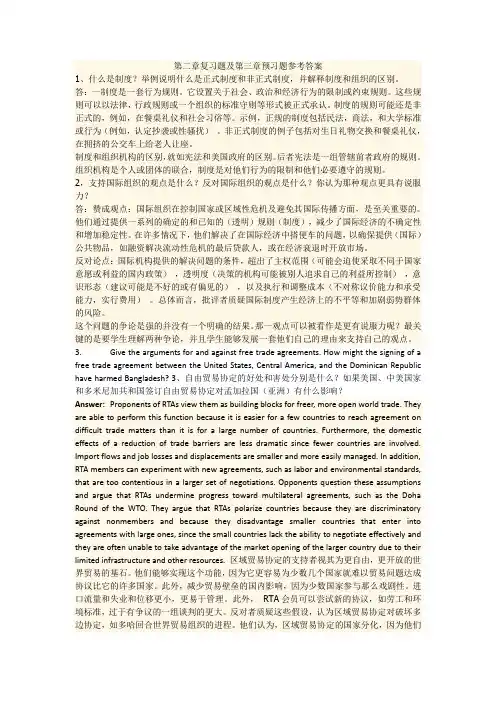
第二章复习题及第三章预习题参考答案1、什么是制度?举例说明什么是正式制度和非正式制度,并解释制度和组织的区别。
答:一制度是一套行为规则。
它设置关于社会、政治和经济行为的限制或约束规则。
这些规则可以以法律,行政规则或一个组织的标准守则等形式被正式承认。
制度的规则可能还是非正式的,例如,在餐桌礼仪和社会习俗等。
示例,正规的制度包括民法,商法,和大学标准或行为(例如,认定抄袭或性骚扰)。
非正式制度的例子包括对生日礼物交换和餐桌礼仪,在拥挤的公交车上给老人让座。
制度和组织机构的区别,就如宪法和美国政府的区别。
后者宪法是一组管辖前者政府的规则。
组织机构是个人或团体的联合,制度是对他们行为的限制和他们必要遵守的规则。
2,支持国际组织的观点是什么?反对国际组织的观点是什么?你认为那种观点更具有说服力?答:赞成观点:国际组织在控制国家或区域性危机及避免其国际传播方面,是至关重要的。
他们通过提供一系列的确定的和已知的(透明)规则(制度),减少了国际经济的不确定性和增加稳定性。
在许多情况下,他们解决了在国际经济中搭便车的问题,以确保提供(国际)公共物品,如融资解决流动性危机的最后贷款人,或在经济衰退时开放市场。
反对论点:国际机构提供的解决问题的条件,超出了主权范围(可能会迫使采取不同于国家意愿或利益的国内政策),透明度(决策的机构可能被别人追求自己的利益所控制),意识形态(建议可能是不好的或有偏见的),以及执行和调整成本(不对称议价能力和承受能力,实行费用)。
总体而言,批评者质疑国际制度产生经济上的不平等和加剧弱势群体的风险。
这个问题的争论是强的并没有一个明确的结果。
那一观点可以被看作是更有说服力呢?最关键的是要学生理解两种争论,并且学生能够发展一套他们自己的理由来支持自己的观点。
3. Give the arguments for and against free trade agreements. How might the signing of a free trade agreement between the United States, Central America, and the Dominican Republic have harmed Bangladesh? 3、自由贸易协定的好处和害处分别是什么?如果美国、中美国家和多米尼加共和国签订自由贸易协定对孟加拉国(亚洲)有什么影响?Answer:Proponents of RTAs view them as building blocks for freer, more open world trade. They are able to perform this function because it is easier for a few countries to reach agreement on difficult trade matters than it is for a large number of countries. Furthermore, the domestic effects of a reduction of trade barriers are less dramatic since fewer countries are involved. Import flows and job losses and displacements are smaller and more easily managed. In addition, RTA members can experiment with new agreements, such as labor and environmental standards, that are too contentious in a larger set of negotiations. Opponents question these assumptions and argue that RTAs undermine progress toward multilateral agreements, such as the Doha Round of the WTO. They argue that RTAs polarize countries because they are discriminatory against nonmembers and because they disadvantage smaller countries that enter into agreements with large ones, since the small countries lack the ability to negotiate effectively and they are often unable to take advantage of the market opening of the larger country due to their limited infrastructure and other resources.区域贸易协定的支持者视其为更自由,更开放的世界贸易的基石。

第一章国际贸易理论的微观基础1.为什么说在决定生产和消费时,相对价格比绝对价格更重要?答案提示:当生产处于生产边界线上,资源则得到了充分利用,这时,要想增加某一产品的生产,必须降低另一产品的生产,也就是说,增加某一产品的生产是有机会机本(或社会成本)的。
生产可能性边界上任何一点都表示生产效率和充分就业得以实现,但究竟选择哪一点,则还要看两个商品的相对价格,即它们在市场上的交换比率。
相对价格等于机会成本时,生产点在生产可能性边界上的位置也就确定了。
所以,在决定生产和消费时,相对价格比绝对价格更重要。
2.仿效图1—6和图1—7,试推导出Y商品的国民供给曲线和国民需求曲线。
答案提示:参照教材中第一章第二节(第26页)的内容,将图1-6(a)中,以横坐标表示Y商品的供给,以纵坐标表示X商品供给,得出相应的生产可能性曲线;然后将图1-6(b)中,以横坐标表示Y商品的供给,以纵坐标表示Y的相对价格P Y/P X,通过类似推导可得出国民供给曲线,国民需求曲线做类似推导即可求出。
3.在只有两种商品的情况下,当一个商品达到均衡时,另外一个商品是否也同时达到均衡?试解释原因。
答案提示:两种商品同时达到均衡。
当一种商品达到均衡时,该商品的相对价格、均衡供给与需求、均衡状态下对生产要素的需求与供给都得以确定,则可得到另一种商品的相对价格、生产要素需求,从而确定该商品的均衡状态下供给和需求。
4.如果生产可能性边界是一条直线,试确定过剩供给(或需求)曲线。
答案提示:参照教材图1-12、图1-13国民供给曲线与国民需求曲线的推导;过剩供给(或需求)曲线的形状,参见教材第30页。
5.如果改用Y商品的过剩供给曲线(B国)和过剩需求曲线(A国)来确定国际均衡价格,那么所得出的结果与图1—13中的结果是否一致?答案提示:相一致。
国际均衡价格将依旧处于贸易前两国相对价格的中间某点。
6.说明贸易条件变化如何影响国际贸易利益在两国间的分配。
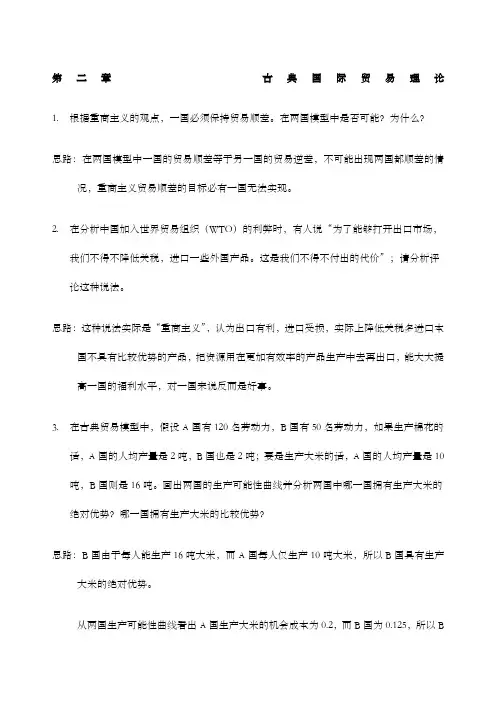
第二章古典国际贸易理论1.根据重商主义的观点,一国必须保持贸易顺差。
在两国模型中是否可能?为什么?思路:在两国模型中一国的贸易顺差等于另一国的贸易逆差,不可能出现两国都顺差的情况,重商主义贸易顺差的目标必有一国无法实现。
2.在分析中国加入世界贸易组织(WTO)的利弊时,有人说“为了能够打开出口市场,我们不得不降低关税,进口一些外国产品。
这是我们不得不付出的代价”;请分析评论这种说法。
思路:这种说法实际是“重商主义”,认为出口有利,进口受损,实际上降低关税多进口本国不具有比较优势的产品,把资源用在更加有效率的产品生产中去再出口,能大大提高一国的福利水平,对一国来说反而是好事。
3.在古典贸易模型中,假设A国有120名劳动力,B国有50名劳动力,如果生产棉花的话,A国的人均产量是2吨,B国也是2吨;要是生产大米的话,A国的人均产量是10吨,B国则是16吨。
画出两国的生产可能性曲线并分析两国中哪一国拥有生产大米的绝对优势?哪一国拥有生产大米的比较优势?思路:B国由于每人能生产16吨大米,而A国每人仅生产10吨大米,所以B国具有生产大米的绝对优势。
从两国生产可能性曲线看出A国生产大米的机会成本为0.2,而B国为0.125,所以B国生产大米的机会成本或相对成本低于A 国,B 国生产大米具有比较优势。
4.理论,决不是个强权理论,只要按照比较优势进行贸易,专业化生产,充分有效地利用资源,穷国也可以得到好处,这不仅可以从Sachs 和Warner 对78个发展中国家贸易与经济发展的关系研究中的得到证实,单从中国改革开放的实践就可以得到说明。
5. 下表列出了加拿大和中国生产1单位计算机和1单位小麦所需的劳动时间。
假定生产计算机和小麦都只用劳动,加拿大的总劳动为600小时,中国总劳动为800小时。
(1) 计算不发生贸易时各国生产计算机的机会成本。
(2) 哪个国家具有生产计算机的比较优势?哪个国家具有生产小麦的比较优势?800 1200(3)如果给定世界价格是1单位计算机交换22单位的小麦,加拿大参与贸易可以从每单位的进口中节省多少劳动时间?中国可以从每单位进口中节省多少劳动时间?如果给定世界价格是1单位计算机交换24单位的小麦,加拿大和中国分别可以从进口每单位的货物中节省多少劳动时间?(4)在自由贸易的情况下,各国应生产什么产品,数量是多少?整个世界的福利水平是提高还是降低了?试用图分析。
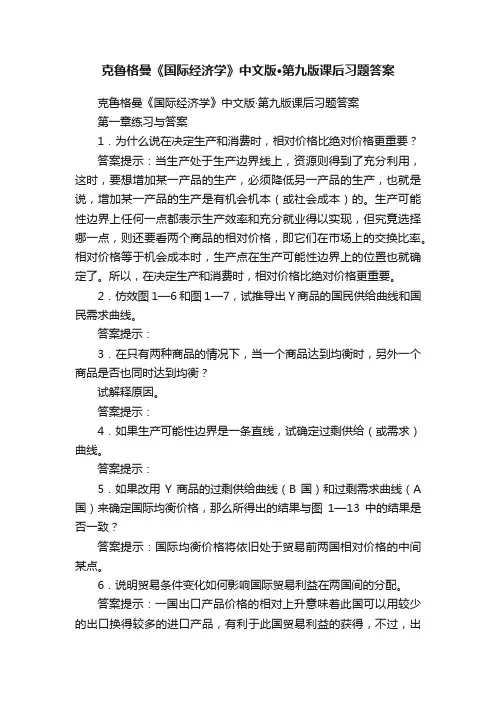
克鲁格曼《国际经济学》中文版·第九版课后习题答案克鲁格曼《国际经济学》中文版·第九版课后习题答案第一章练习与答案1.为什么说在决定生产和消费时,相对价格比绝对价格更重要?答案提示:当生产处于生产边界线上,资源则得到了充分利用,这时,要想增加某一产品的生产,必须降低另一产品的生产,也就是说,增加某一产品的生产是有机会机本(或社会成本)的。
生产可能性边界上任何一点都表示生产效率和充分就业得以实现,但究竟选择哪一点,则还要看两个商品的相对价格,即它们在市场上的交换比率。
相对价格等于机会成本时,生产点在生产可能性边界上的位置也就确定了。
所以,在决定生产和消费时,相对价格比绝对价格更重要。
2.仿效图1—6和图1—7,试推导出Y商品的国民供给曲线和国民需求曲线。
答案提示:3.在只有两种商品的情况下,当一个商品达到均衡时,另外一个商品是否也同时达到均衡?试解释原因。
答案提示:4.如果生产可能性边界是一条直线,试确定过剩供给(或需求)曲线。
答案提示:5.如果改用Y商品的过剩供给曲线(B国)和过剩需求曲线(A 国)来确定国际均衡价格,那么所得出的结果与图1—13中的结果是否一致?答案提示:国际均衡价格将依旧处于贸易前两国相对价格的中间某点。
6.说明贸易条件变化如何影响国际贸易利益在两国间的分配。
答案提示:一国出口产品价格的相对上升意味着此国可以用较少的出口换得较多的进口产品,有利于此国贸易利益的获得,不过,出口价格上升将不利于出口数量的增加,有损于出口国的贸易利益;与此类似,出口商品价格的下降有利于出口商品数量的增加,但是这意味着此国用较多的出口换得较少的进口产品。
对于进口国来讲,贸易条件变化对国际贸易利益的影响是相反的。
7.如果国际贸易发生在一个大国和一个小国之间,那么贸易后,国际相对价格更接近于哪一个国家在封闭下的相对价格水平?答案提示:贸易后,国际相对价格将更接近于大国在封闭下的相对价格水平。

课后习题第一章绪论(一) 选择题1.国际经济学在研究资源配置时,是以()作为基本的经济单位来划分的。
A. 企业B.个人C.政府D.国家2.国际经济学研究的对象是()A国际商品流动B世界范围内的稀缺资源的最优配置C国际收支平衡D各国之间的经济活动和经济关系3.从国际间经济资源流动的难易度看,()流动最容易A商品B资本C人员D技术答案提示:1.D 2. B D 3.C(二)问答题1.试述国际经济学和国内经济学的关系。
答案提示:(1)联系:国际经济学与国内经济学研究的经济活动是相似的,面临的主要问题也是相似的;(2)最主要的区别是国际经济的民族国家性。
第二章古典的国际贸易理论(一)选择题本国生产A、B、C、D四种产品的单位劳动投入分别为1、2、4、15,外国生产这四种产品的单位劳动投入分别为12、18、24、30,根据李嘉图模型,本国在哪种产品上拥有最大比较优势?在哪种产品上拥有最大比较劣势?( )(a)D、A (b)C、B (c)A、D (d)B、C答案:C (二)问答题1.亚当·斯密对国际贸易理论的主要贡献有哪些?答案提示:亚当·斯密的主要贡献是:(1)抨击了重商主义;(2)提出了绝对优势之一概念;(3)强调国际分工是使国民财富增加的最重要手段。
2.绝对优势理论和比较优势理论的区别是什么?答案提示:(1)绝对优势理论强调,国与国之间劳动生产率的绝对差异导致的技术水平的差异是产生国际贸易的主要原因;(2)比较优势理论强调,劳动生产率的相对差异导致的技术水平的差异是产生国际贸易的主要原因。
(三)计算题1.根据下面两个表中的数据,确定(1)贸易前的相对价格;(2)比较优势型态。
表1 X、Y的单位产出所需的劳动投入A国 B国X Y 621512表2 X、Y的单位产出所需的劳动投入 A国 B国X Y 10455答案提示:首先将劳动投入转化为劳动生产率,然后应用与本章正文中一样的方法进行比较。
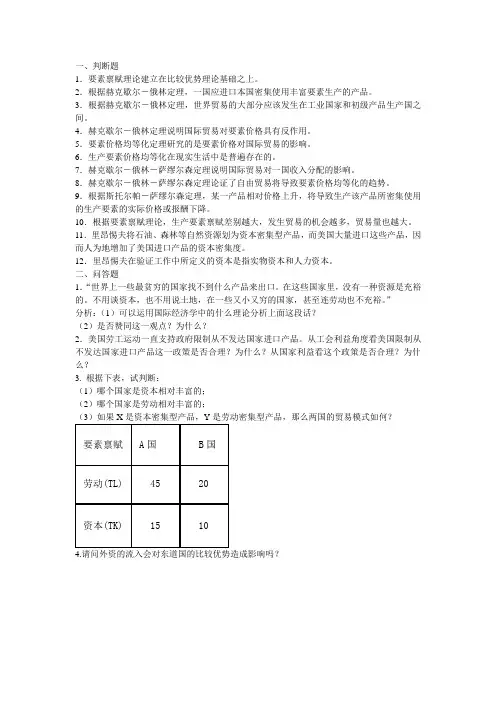
一、判断题1.要素禀赋理论建立在比较优势理论基础之上。
2.根据赫克歇尔-俄林定理,一国应进口本国密集使用丰富要素生产的产品。
3.根据赫克歇尔-俄林定理,世界贸易的大部分应该发生在工业国家和初级产品生产国之间。
4.赫克歇尔-俄林定理说明国际贸易对要素价格具有反作用。
5.要素价格均等化定理研究的是要素价格对国际贸易的影响。
6.生产要素价格均等化在现实生活中是普遍存在的。
7.赫克歇尔-俄林-萨缪尔森定理说明国际贸易对一国收入分配的影响。
8.赫克歇尔-俄林-萨缪尔森定理论证了自由贸易将导致要素价格均等化的趋势。
9.根据斯托尔帕-萨缪尔森定理,某一产品相对价格上升,将导致生产该产品所密集使用的生产要素的实际价格或报酬下降。
10.根据要素禀赋理论,生产要素禀赋差别越大,发生贸易的机会越多,贸易量也越大。
11.里昂惕夫将石油、森林等自然资源划为资本密集型产品,而美国大量进口这些产品,因而人为地增加了美国进口产品的资本密集度。
12.里昂惕夫在验证工作中所定义的资本是指实物资本和人力资本。
二、问答题1.“世界上一些最贫穷的国家找不到什么产品来出口。
在这些国家里,没有一种资源是充裕的。
不用谈资本,也不用说土地,在一些又小又穷的国家,甚至连劳动也不充裕。
”分析:(1)可以运用国际经济学中的什么理论分析上面这段话?(2)是否赞同这一观点?为什么?2.美国劳工运动一直支持政府限制从不发达国家进口产品。
从工会利益角度看美国限制从不发达国家进口产品这一政策是否合理?为什么?从国家利益看这个政策是否合理?为什么?3. 根据下表,试判断:(1)哪个国家是资本相对丰富的;(2)哪个国家是劳动相对丰富的;。
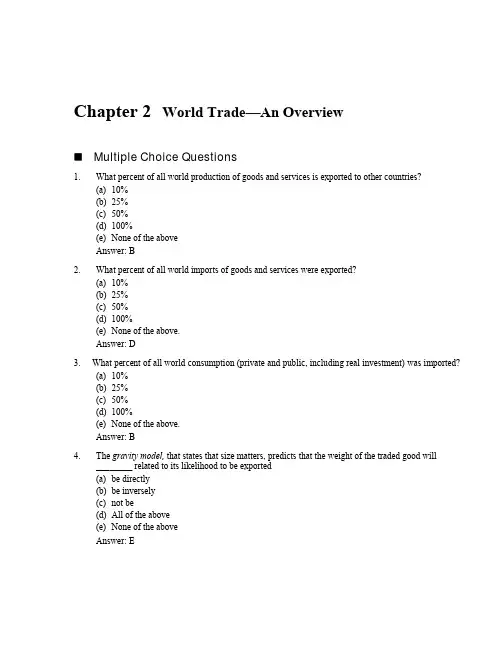
Chapter 2 World Trade—An OverviewMultiple Choice Questions1. What percent of all world production of goods and services is exported to other countries?(a) 10%(b) 25%(c) 50%(d) 100%(e) None of the aboveAnswer: B2.What percent of all world imports of goods and services were exported?(a) 10%(b) 25%(c) 50%(d) 100%(e) None of the above.Answer: D3. What percent of all world consumption (private and public, including real investment) was imported?(a) 10%(b) 25%(c) 50%(d) 100%(e) None of the above.Answer: B4. The gravity model, that states that size matters,predicts that the weight of the traded good will________ related to its likelihood to be exported(a) be directly(b) be inversely(c) not be(d) All of the above(e) None of the aboveAnswer: E12 Krugman/Obstfeld •Seventh Edition5. The gravity model offers a logical explanation for the fact that(a) Trade between Asia and the U.S. has grown faster than NAFTA trade.(b) Trade in services has grown faster than trade in goods.(c) Trade in manufactures has grown faster than in agricultural products(d) Intra-European Union trade exceeds International Trade of the European Union.(e) None of the aboveAnswer: D6. The gravity model suggests that over time(a) trade between neighboring countries will increase(b) trade between all countries will increase(c) world trade will eventually be swallowed by a black hole.(d) trade between Earth and other planets will become important(e) None of the aboveAnswer: E7. The gravity model explains why(a) trade between Sweden and Germany exceeds that between Sweden and Spain(b) countries with oil reserves tend to export oil.(c) capital rich countries export capital intensive products(d) intra-industry trade is relatively more important than other forms of trade between neighboringcountries.(e) None of the aboveAnswer: A8. According to the gravity model, a characteristic that tends to affect the probability of trade existingbetween any two countries is(a) their cultural affinity(b) the average weight/value of their traded goods(c) their colonial—historical ties(d) the distance between them(e) the number of varieties produced on the average by their industries.Answer: D9. The one single trade partner country of the U.S. is(a) United Kingdom(b) Canada(c) Mexico(d) Japan(e) IsraelAnswer: BChapter 2 World Trade—An Overview 13 10. In general which of the following tend to promote the probability of trade volumes between twocountries(a) Linguistic and/or cultural affinity(b) Historical ties(c) Sizes of economies(d) Mutual membership in preferential trade agreements(e) All of the aboveAnswer: E11. Since World War II (the early 1950s), the proportion of most countries’ production being used insome other country(a) remained constant(b) increased(c) decreased(d) fluctuated widely with no clear trend(e) both (a) and (d) aboveAnswer: B12. Since World War II, the likelihood that foreign markets would gain importance in the averageexporters’ as a source of profits(a) remained constant(b) increased(c) decreased(d) fluctuated widely with no clear trend(e) both (a) and (d) aboveAnswer: B13. Since World War II, the likelihood that any single item in the typical consumption basket of aconsumer in the U.S. originated outside of the U.S.(a) remained constant(b) increased(c) decreased(d) fluctuated widely with no clear trend(e) both (a) and (d) aboveAnswer: B14. Since World War II, the likelihood that the job a new college graduate will be directly or indirectlyaffected by world trade(a) remained constant(b) increased(c) decreased(d) fluctuated widely with no clear trend(e) both (a) and (d) aboveAnswer: B14 Krugman/Obstfeld •Seventh Edition15. Since World War II, the relative importance of raw materials, including oil, in total world trade(a) remained constant(b) increased(c) decreased(d) fluctuated widely with no clear trend(e) both (a) and (d) aboveAnswer: C16. In the current Post-Industrial economy, international trade in services (including banking andfinancial services)(a) dominates world trade(b) does not exist(c) is relatively small(d) is relatively stagnant(e) None of the aboveAnswer: C17. In the pre-World War I period, the U.S. exported primarily(a) manufactured goods(b) services(c) primary products including agricultural(d) technology intensive products(e) None of the aboveAnswer: C18. In the pre-World War I period, the United Kingdom exported primarily(a) manufactured goods(b) services(c) primary products including agricultural(d) technology intensive products(e) None of the aboveAnswer: A19. In the pre-World War I period, the United Kingdom imported primarily(a) manufactured goods(b) services(c) primary products including agricultural(d) technology intensive products(e) None of the aboveAnswer: CChapter 2 World Trade—An Overview 1520. In the present, most of the exports from China are in(a) manufactured goods(b) services(c) primary products including agricultural(d) technology intensive products(e) None of the aboveAnswer: A21. Which of the following does not explain the extent of trade between Ireland and the U.S.?(a) Historical ties(b) Cultural Linguistic ties(c) Gravity model(d) Multinational Corporations(e) None of the aboveAnswer: CEssay Questions1. When comparing the composition of world trade in the early 20th Century to the early 21st Century,we find major compositional changes. These include a relative decline in agricultural and primary-products (including raw materials). How would you explain this in terms of broad historicaldevelopments during this period?Answer: The typical composition of world production during this period experienced major changes. Focusing on today’s Industrialized Countries (primarily members of the O ECD),the industrial-employment composition was focused primarily on agriculture. Most valuewas in land. The predominant single consumption category was food. Since then, theeconomies shifted from the agricultural to the manufacturing sectors (continuing trendsbegun over a century earlier in the industrial revolution). Incomes rose, and consumptionshifted in favor of (increasingly affordable) manufactures. Both income and priceelasticities were greater in manufactures than in agricultural products. At the same timethere was a steady tendency for synthetic (manufactured) inputs to replace agriculturalbased raw materials and industrial inputs. Hence, trade and of course international tradeconformed to overall changes in patterns of world production and consumption.2. In the past half century, the developing countries have experienced major compositional shifts fromexports of primary products (including agricultural and raw materials) to exports of manufactures.How might you explain this in terms of broad historical developments during this period?16 Krugman/Obstfeld •Seventh EditionAnswer: Any discussion of the export experience of the developing countries must first clarify the problem of definitional inclusion. In particular, the exports of the (non-OECD) developingcountries, has become increasingly dominated by the experience of a relatively smallnumber of countries in South-East Asia, termed the New Industrialized Countries (NICs).Since they experienced both very rapid increases in their exports, and very rapid increasesin the manufactured component of their exports, their experience alone may explain thebulk of the observed phenomenon. Many would exclude the NICs from the developingcountry category so as to be able to focus the discussion on a more representative sampleof (the over 100) developing countries. More recently, a second wave of East Asiancountries, notably including China have replicated the experience of the NICs, and thisagain muddies the water for one interested in focusing on the export experience of thegrowing heterogenous category, developing countries.Chapter 2 World Trade—An Overview 17 Another explanation of the growing dependence on manufactured exports on the part ofthe developing countries, follows the answer to question 1 above. Since the consumer( including industrial consumer) markets in OECD countries were rapidly shifting awayfrom primary products, these markets were rapidly disappearing.In addition, in the world markets for primary products was generally limited by low priceand especially income elasticities; agricultural sectors tended to be highly and rigidlyprotected in potential OECD markets; and escalating effective tariff structures leviedsystematically large levels of protection against the primary exports of the developingcountries; success in world exports had to be pursued outside of the traditional primaryexports of these countries.3. The Neoclassical Heckscher-Ohlin model assumes that all producers of any industrial product hasknowledge of, and may avail itself of the same production technology available to producers in any other country. Many have flagged this identical technology assumption as an unrealistic assumption.During the past half century, the relative importance of the Multinational Corporations (MNCs) in world trade has steadily increased. How w ould this trend affect the realism of the “identicaltechnology” assumption?Answer: Noting that MNC plants tend to use more labor intensive production processes in countries where labor tends to be relatively cheap (both in “low” tech , e.g. Nike, and“high tech,” e.g. Motorola), one may argue that MNCs use different technologies indeveloping countries. However, this is a gross misunderstanding of the identicaltechnology assumption . It is axiomatically obvious that if the same MNC is producingsomething in both labor abundant and labor scarce using different processes, itnevertheless has knowledge (intimate knowledge in the case of proprietary patentedprocesses) of available technology. The fact that the MNC may choose not to apply thesame degree of capital intensity in environments with greatly different relative factorprices in no way lessens the fact that the Heckscher-Ohlin identical technologyassumption is strengthened due to the growing relative strength of MNCs in developingcountries. An additional fact that strengthens this argument is that, as compared to theearly 1950s, a growing proportion of MNCs are themselves based in developing countries,such as China and Brazil.4. One of the major political developments of the past several decades is the growing size andeconomic/monetary integration of the European Union. What effect do you think this will have on international trade between countries?Answer: The growing economic integration between the various countries of Europe, both the old and existing members of the European Union (EU) and the new countries joining it(including perhaps soon, Turkey), means that the barriers to trade are steadily falling in aregion that has traditionally dominated world trade. The common monetary unit should initself go far to promote inter-country trade within the growing EU (judging by thepositive historical effect of a single currency in the U.S.). The standardization oftransportation (including railroad gauges, highway signs etc.) and product codes will alsopromote expansion of intra-EU trade. The decline in the probability of political conflictassociated with this comprehensive economic union, plus conscious attempts to cooperatein fiscal and monetary policy stances again point to growing international trade, allowingthese countries to increasingly enjoy the fruits of potential positive scale economies, andmore traditional classical and neo-classical gains from trade. The scale economies willalso tend to increase trade between the EU and other countries.18 Krugman/Obstfeld •Seventh Edition5. The Services sector has been steadily rising in relative importance in GDP of the United States, aswell as elsewhere around the world. Since “services” have been identified as “non-tradables” (e.g. it is difficult to export haircuts), it may be argued that this trend will likely slow the rapid growth in international trade. Discuss.Answer: This argument stands on questionable logical foundations. The past half century has seena steady growth in the absolute and relative importance of international trade. This trendhas been reversed only by global conflicts, i.e. the two World Wars. This trend hasremained steady and robust despite major compositional shifts (e.g. from primary tomanufacturing), and location shifts (e.g., the sudden rise of NICs as significant group ofexporters). The trend will probably continue into the reasonable future, fueled by bothsuper-regional preferential trade regions and a growing impact of the multilateral forces,represented institutionally by the World Trade Organization (WTO)—as illustrated by therecent abolishment of the epitome cartelized trade, the world trade in textiles. Driven bytechnology—especially in the areas of communication and transportation—a reversal ofthe growing trade trend is not likely in t he near future. In any case, many “services” are infact quite tradable. Examples would be financial services, long-distance teaching, “help-desk” outsourcing, consulting and management services and others. In fact, when a touristgets a haircut, we s ee that even haircuts become a “tradable” service.。
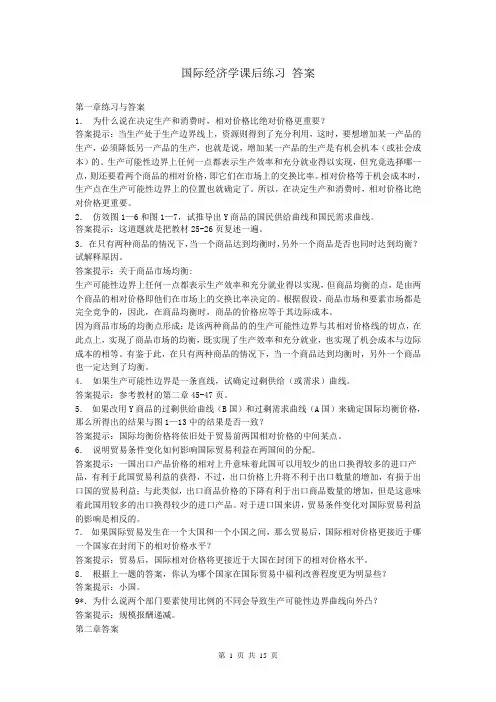
国际经济学课后练习答案第一章练习与答案1.为什么说在决定生产和消费时,相对价格比绝对价格更重要?答案提示:当生产处于生产边界线上,资源则得到了充分利用,这时,要想增加某一产品的生产,必须降低另一产品的生产,也就是说,增加某一产品的生产是有机会机本(或社会成本)的。
生产可能性边界上任何一点都表示生产效率和充分就业得以实现,但究竟选择哪一点,则还要看两个商品的相对价格,即它们在市场上的交换比率。
相对价格等于机会成本时,生产点在生产可能性边界上的位置也就确定了。
所以,在决定生产和消费时,相对价格比绝对价格更重要。
2.仿效图1—6和图1—7,试推导出Y商品的国民供给曲线和国民需求曲线。
答案提示:这道题就是把教材25-26页复述一遍。
3.在只有两种商品的情况下,当一个商品达到均衡时,另外一个商品是否也同时达到均衡?试解释原因。
答案提示:关于商品市场均衡:生产可能性边界上任何一点都表示生产效率和充分就业得以实现,但商品均衡的点,是由两个商品的相对价格即他们在市场上的交换比率决定的。
根据假设,商品市场和要素市场都是完全竞争的,因此,在商品均衡时,商品的价格应等于其边际成本。
因为商品市场的均衡点形成:是该两种商品的的生产可能性边界与其相对价格线的切点,在此点上,实现了商品市场的均衡,既实现了生产效率和充分就业,也实现了机会成本与边际成本的相等。
有鉴于此,在只有两种商品的情况下,当一个商品达到均衡时,另外一个商品也一定达到了均衡。
4.如果生产可能性边界是一条直线,试确定过剩供给(或需求)曲线。
答案提示:参考教材的第二章45-47页。
5.如果改用Y商品的过剩供给曲线(B国)和过剩需求曲线(A国)来确定国际均衡价格,那么所得出的结果与图1—13中的结果是否一致?答案提示:国际均衡价格将依旧处于贸易前两国相对价格的中间某点。
6.说明贸易条件变化如何影响国际贸易利益在两国间的分配。
答案提示:一国出口产品价格的相对上升意味着此国可以用较少的出口换得较多的进口产品,有利于此国贸易利益的获得,不过,出口价格上升将不利于出口数量的增加,有损于出口国的贸易利益;与此类似,出口商品价格的下降有利于出口商品数量的增加,但是这意味着此国用较多的出口换得较少的进口产品。

title国际经济学(首都经济贸易大学) 中国大学mooc答案100分最新版content第一章比较优势理论比较优势理论1、亚当·斯密认为,国际贸易的基础是()A:比较优势B:绝对优势C:规模经济D:以上都错答案: 绝对优势2、外凸的生产可能性曲线表明生产过程中的机会成本()A:递增B:递减C:不变D:先递增后递减答案: 递增3、按照比较优势的原则,劳动丰裕的国家应该进口()A:资本密集型产品B:劳动密集型产品C:不需要进口D:技术密集型产品答案: 资本密集型产品4、以下哪项不是重商主义倡导的观点()A:自由贸易B:鼓励出口C:限制进口D:重视金银的积累答案: 自由贸易5、比较优势理论是()提出的A:亚当·斯密B:大卫·李嘉图C:凯恩斯D:克鲁格曼答案: 大卫·李嘉图6、如果国家A每1单位劳动时间可以生产3单位X或者3单位Y,国家B每1单位劳动时间可以生产1单位X或者3单位Y,那么()A:国家A在生产X上具有比较劣势B:国家B在生产Y上具有比较劣势C:国家A在生产X上具有比较优势D:国家A在任何产品生产上都不具有比较优势答案: 国家A在生产X上具有比较优势7、李嘉图解释比较优势理论的基础是()A:劳动价值论B:机会成本理论C:规模报酬递减D:以上都正确答案: 劳动价值论8、两个国家相对产品价格的差异可能是基于()A:要素禀赋的差异B:技术的差异C:消费者偏好的差异D:以上都正确答案: 以上都正确9、假定机会成本不变,大国和小国进行贸易()A:大国可能获得全部贸易利益B:小国可能获得全部贸易利益C:大国和小国平分贸易利益D:以上都不正确答案: 小国可能获得全部贸易利益10、如果国家A每1单位劳动时间可以生产3单位X或者3单位Y,国家B每1单位劳动时间可以生产1单位X或者3单位Y,如果国家A拿3单位X交换3单位Y,那么()A:国家A获利2单位XB:国家B获利6单位YC:国家A获利3单位YD:国家B获利3单位Y答案: 国家B获利6单位Y11、李嘉图解释比较理论的基础是()A:劳动价值论B:机会成本理论C:规模报酬递减D:以上都正确答案: 劳动价值论12、假定机会成本不变,大国和小国进行贸易:()A:大国可能获得全部贸易利益B:小国可能获得全部贸易利益C:大国和小国平分贸易利益D:以上都不正确答案: 以上都不正确作业第一章比较优势理论比较优势理论1、请简要阐述重商主义的主要观点。
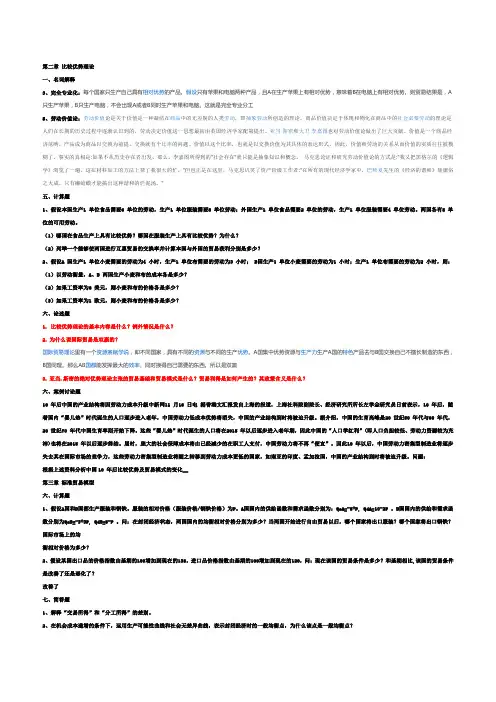
第二章比较优势理论一、名词解释3、完全专业化:每个国家只生产自己具有相对优势的产品。
假设只有苹果和电脑两种产品,且A在生产苹果上有相对优势,意味着B在电脑上有相对优势。
则贸易结果是,A 只生产苹果,B只生产电脑,不会出现A或者B同时生产苹果和电脑。
这就是完全专业分工5、劳动价值论:劳动价值论是关于价值是一种凝结在商品中的无差别的人类劳动,即抽象劳动所创造的理论。
商品价值决定于体现和物化在商品中的社会必要劳动的理论是人们在长期的历史过程中逐渐认识到的。
劳动决定价值这一思想最初由英国经济学家配第提出。
亚当·斯密和大卫·李嘉图也对劳动价值论做出了巨大贡献。
价值是一个商品经济范畴。
产品成为商品以交换为前提。
交换就有个比率的问题。
价值以这个比率,也就是以交换价值为其具体的表达形式,因此,价值和劳动的关系从而价值的实质往往被模糊了。
事实的真相是:如果不从历史存在者出发,那么,李嘉图所得到的"社会存在"就只能是抽象知识和概念。
马克思论证和研究劳动价值论的方式是:"我又把黑格尔的《逻辑学》浏览了一遍,这在材料加工的方法上帮了我很大的忙。
"但也正是在这里,马克思讥笑了资产阶级工作者:"在所有的现代经济学家中,巴师夏先生的《经济的谐和》集庸俗之大成。
只有癞蛤蟆才能搞出这种谐和的烂泥汤。
"五、计算题1、假设本国生产1 单位食品需要6 单位的劳动,生产1 单位服装需要8 单位劳动;外国生产1 单位食品需要2 单位的劳动,生产1 单位服装需要4 单位劳动。
两国各有8 单位的可用劳动。
(1)哪国在食品生产上具有比较优势?哪国在服装生产上具有比较优势?为什么?(2)列举一个能够使两国进行互惠贸易的交换率并计算本国与外国的贸易获利分别是多少?2、假设A 国生产1 单位小麦需要的劳动为4 小时,生产1 单位布需要的劳动为3 小时; B国生产1 单位小麦需要的劳动为1 小时;生产1 单位布需要的劳动为2 小时,则:(1)以劳动衡量,A、B 两国生产小麦和布的成本各是多少?(2)如果工资率为6 美元,则小麦和布的价格各是多少?(3)如果工资率为1 欧元,则小麦和布的价格各是多少?六、论述题1. 比较优势理论的基本内容是什么?例外情况是什么?2.为什么说国际贸易是双赢的?国际贸易理论里有一个资源禀赋学说,即不同国家,具有不同的资源与不同的生产优势。
第一章练习与答案1.为什么说在决定生产和消费时,相对价格比绝对价格更重要?答案提示:当生产处于生产边界线上,资源则得到了充分利用,这时,要想增加某一产品的生产,必须降低另一产品的生产,也就是说,增加某一产品的生产是有机会机本(或社会成本)的。
生产可能性边界上任何一点都表示生产效率和充分就业得以实现,但究竟选择哪一点,则还要看两个商品的相对价格,即它们在市场上的交换比率。
相对价格等于机会成本时,生产点在生产可能性边界上的位置也就确定了。
所以,在决定生产和消费时,相对价格比绝对价格更重要。
2.仿效图1—6和图1—7,试推导出Y商品的国民供给曲线和国民需求曲线。
答案提示:3.在只有两种商品的情况下,当一个商品达到均衡时,另外一个商品是否也同时达到均衡?试解释原因。
答案提示:4.如果生产可能性边界是一条直线,试确定过剩供给(或需求)曲线。
答案提示:5.如果改用Y商品的过剩供给曲线(B国)和过剩需求曲线(A国)来确定国际均衡价格,那么所得出的结果与图1—13中的结果是否一致?答案提示:国际均衡价格将依旧处于贸易前两国相对价格的中间某点。
6.说明贸易条件变化如何影响国际贸易利益在两国间的分配。
答案提示:一国出口产品价格的相对上升意味着此国可以用较少的出口换得较多的进口产品,有利于此国贸易利益的获得,不过,出口价格上升将不利于出口数量的增加,有损于出口国的贸易利益;与此类似,出口商品价格的下降有利于出口商品数量的增加,但是这意味着此国用较多的出口换得较少的进口产品。
对于进口国来讲,贸易条件变化对国际贸易利益的影响是相反的。
7.如果国际贸易发生在一个大国和一个小国之间,那么贸易后,国际相对价格更接近于哪一个国家在封闭下的相对价格水平?答案提示:贸易后,国际相对价格将更接近于大国在封闭下的相对价格水平。
8.根据上一题的答案,你认为哪个国家在国际贸易中福利改善程度更为明显些?答案提示:小国。
9*.为什么说两个部门要素使用比例的不同会导致生产可能性边界曲线向外凸?答案提示:第二章答案1.根据下面两个表中的数据,确定(1)贸易前的相对价格;(2)比较优势型态。
这是我在网上找的,大多数题目都有,朋友们可以参考一下!有一点不确定的是G—L指数,大家再上网查看看,是乘100还是乘1?希望可以给你们帮助,预祝大家顺利通过!第二章古典国际贸易理论在古典贸易模型中,假设A国有120名劳动力,B国有50名劳动力,如果生产棉花的话,A国的人均产量是2吨,B国也是2吨;要是生产大米的话,A国的人均产量是10吨,B国则是16吨。
画出两国的生产可能性曲线并分析两国中哪一国拥有生产大米的绝对优势?哪一国拥有生产大米的比较优势?思路:B国由于每人能生产16吨大米,而A国每人仅生产10吨大米,所以B国具有生产大米的绝对优势。
从两国生产可能性曲线看出A国生产大米的机会成本为0.2,而B国为0.125,所以B国生产大米的机会成本或相对成本低于A国,B国生产大米具有比较优势。
1.下表列出了加拿大和中国生产1单位计算机和1单位小麦所需的劳动时间。
假定生产计算机和小麦都只用劳动,加拿大的总劳动为600小时,中国总劳动为800小时。
(1)计算不发生贸易时各国生产计算机的机会成本。
(2)哪个国家具有生产计算机的比较优势?哪个国家具有生产小麦的比较优势?(3)如果给定世界价格是1单位计算机交换22单位的小麦,加拿大参与贸易可以从每单位的进口中节省多少劳动时间?中国可以从每单位进口中节省多少劳动时间?如果给定世界价格是1单位计算机交换24单位的小麦,加拿大和中国分别可以从进口每单位的货物中节省多少劳动时间?(4)在自由贸易的情况下,各国应生产什么产品,数量是多少?整个世界的福利水平是提高还是降低了?试用图分析。
(以效用水平来衡量福利水平)思路:(1)中国生产计算机的机会成本为100/4=25,加拿大为60/3=20(2)因为加拿大生产计算机的机会成本比中国低,所以加拿大具有生产者计算机的比较优势,中国就具有生产小麦的比较优势。
(3)如果各国按照比较优势生产和出口,加拿大进口小麦出口计算机,中国进口计算机出口小麦。
Overview of Section I:International Trade TheorySection I of the text is comprised of six chapters:Chapter 2World Trade: An OverviewChapter 3Labor Productivity and Comparative Advantage: The Ricardian ModelChapter 4Resources, Comparative Advantage, and Income DistributionChapter 5The Standard Trade ModelChapter 6Economies of Scale, Imperfect Competition, and International TradeChapter 7International Factor MovementsSection I OverviewSection I of the text presents the theory of international trade. The intent of this section is to explorethe motives for and implications of patterns of trade between countries. The presentation proceeds by introducing successively more general models of trade, where the generality is provided by increasing the number of factors used in production, by increasing the mobility of factors of production across sectorsof the economy, by introducing more general technologies applied to production, and by examining different types of market structure. Throughout Section I, policy concerns and current issues are usedto emphasize the relevance of the theory of international trade for interpreting and understanding our economy.Chapter 2 gives a brief overview of world trade. In particular, it discusses what we know about the quantities and pattern of world trade today. The chapter uses the empirical relationship known asthe gravity model as a framework to describe trade. This framework describes trade as a function of the size of the economies involved and their distance. It can then be used to see where countries are trading more or less than expected. The chapter also notes the growth in world trade over the previous decades and uses the previous era of globalization (pre-WWI) as context for today’s experie nce.Chapter 3 introduces you to international trade theory through a framework known as the Ricardian model of trade. This model addresses the issue of why two countries would want to trade with each other. This model shows how mutually-beneficial trade arises when there are two countries, each with one factor of production which can be applied toward producing each of two goods. Key concepts are introduced, such as the production possibilities frontier, comparative advantage versus absolute advantage, gains from trade, relative prices, and relative wages across countries.Chapter 4 introduces what is known as the classic Heckscher-Ohlin model of international trade. Using this framework, you can work through the effects of trade on wages, prices and output. Many important and intuitive results are derived in this chapter including: the Rybczynski Theorem, the Stolper-Samuelson Theorem, and the Factor Price Equalization Theorem. Implications of the Heckscher-Ohlin model for the pattern of trade among countries are discussed, as are the failures of empirical evidence to confirmthe predictions of the theory. The chapter also introduces questions of political economy in trade. One4 Krugman/Obstfeld •International Economics: Theory and Policy, Eighth Editionimportant reason for this addition to the model is to consider the effects of trade on income distribution. This approach shows that while nations generally gain from international trade, it is quite possible that specific groups within these nations could be harmed by this trade. This discussion, and related questions about protectionism versus globalization, becomes broader and even more interesting as you work through the models and different assumptions of subsequent chapters.Chapter 5 presents a general model of international trade which admits the models of the previous chapters as special cases. This “standard trade model” is depicted graphically by a general equilibrium trade model as applied to a small open economy. Relative demand and relative supply curves are used to analyze a variety of policy issues, such as the effects of economic growth, the transfer problem, and the effects of trade tariffs and production subsidies. The appendix to the chapter develops offer curve analysis.While an extremely useful tool, the standard model of trade fails to account for some important aspectsof international trade. Specifically, while the factor proportions Heckscher-Ohlin theories explain some trade flows between countries, recent research in international economics has placed an increasing emphasis on economies of scale in production and imperfect competition among firms.Chapter 6 presents models of international trade that reflect these developments. The chapter begins by reviewing the concept of monopolistic competition among firms, and then showing the gains from trade which arise in such imperfectly competitive markets. Next, internal and external economies of scale in production and comparative advantage are discussed. The chapter continues with a discussion of the importance of intra-industry trade, dumping, and external economies of production. The subject matterof this chapter is important since it shows how gains from trade arise in ways that are not suggested by the standard, more traditional models of international trade. The subject matter also is enlightening given the increased emphasis on intra-industry trade in industrialized countries.Chapter 7 focuses on international factor mobility. This departs from previous chapters which assumed that the factors of production available for production within a country could n ot leave a country’s borders. Reasons for and the effects of international factor mobility are discussed in the context of a one-factor (labor) production and trade model. The analysis of the international mobility of labor motivates a further discussion of international mobility of capital. The international mobility of capital takes the form of international borrowing and lending. This facilitates the discussion of inter-temporal production choices and foreign direct investment behavior.Chapter 2World Trade: An Overview⏹Chapter OrganizationWho Trades with Whom?Size Matters: the Gravity ModelThe Logic of the Gravity ModelUsing the Gravity Model: Looking for AnomaliesImpediments to Trade: Distance, Barriers, and BordersThe Changing Pattern of World TradeHas the World Gotten SmallerWhat Do We Trade?Service OutsourcingDo Old Rules Still Apply?Summary⏹Key ThemesBefore entering into a series of theoretical models that explain why countries trade across borders and the benefits of this trade (Chapters 3–11), Chapter 2 considers the pattern of world trade which we observe today. The core idea of the chapter is the empirical model known as the gravity model. The gravity model is based on the observations that: (1) countries tend to trade with other nearby economies and (2) countries’ trade is proportional to their size. The model is called the gravity model as it is similar in form to the physics equation that describes the pull of one body on another as proportional to their size and distance.The basic form of the gravity equation is T ij=A⨯Y i⨯Y j/D ij. The logic supporting this equation is that large countries have large incomes to spend on imports and produce a large quantity of goods to sell as exports. This means that the larger either trade partner, the larger the volume of trade between them. At the same time, the distance between two trade partners can substitute for the transport costs that they face as well as proxy for more intangible aspects of a trading relationship such as the ease of contact for firms. This model can be used to estimate the predicted trade between two countries and look for anomalies in trade patterns. The text shows an example where the gravity model can be used to demonstrate the importance of national borders in determining trade flows. According to many estimates, the border between the U.S. and Canada has the impact on trade equivalent to roughly 2000 miles of distance. Other factors, such as tariffs, trade agreements, and common language can all affect trade and can be incorporated into the gravity model.6 Krugman/Obstfeld •International Economics: Theory and Policy, Eighth EditionThe chapter also considers the way trade has evolved over time. While people often feel that the modern era has seen unprecedented globalization, in fact, there is precedent. From the end of the 19th century to World War I, the economies of different countries were quite connected. Trade as a share of GDP was higher in 1910 than 1960, and only recently have trade levels surpassed the pre World War trade. The nature of trade has change though. The majority of trade is in manufactured goods with agriculture and mineral products (and oil) making up less than 20% of world trade. Even developing countries now export primarily manufactures. In contrast, a century ago, more trade was in primary products as nations tended to trade for things that literally could not be grown or found at home. Today, the reasons for trade are more varied and the products we trade are ever changing (for example, the rise in trade of things like call centers). The chapter concludes by focusing on o ne particular expansion of what is “tradable”—the increase in services trade. Modern information technology has greatly expanded what can be traded as the person staffing a call center, doing your accounting, or reading your X-ray can literally be half-way around the world. While still relatively rare, the potential for a large increase in service outsourcing is an important part of how trade will evolve in the coming decades. The next few chapters will explain the theory of why nations trade.Answers to Textbook Problems1. We saw that not only is GDP important in explaining how much two countries trade, but also,distance is crucial. Given its remoteness, Australia faces relatively high costs of transporting imports and exports, thereby reducing the attractiveness of trade. Since Canada has a border with a largeeconomy (the U.S.) and Australia is not near any other major economy, it makes sense that Canada would be more open and Australia more self-reliant.2. Mexico is quite close to the U.S., but it is far from the European Union (EU). So it makes sense thatit trades largely with the U.S. Brazil is far from both, so its trade is split between the two. Mexico trades more than Brazil in part because it is so close to a major economy (the U.S.) and in partbecause it is a member of a free trade agreement with a large economy (NAFTA). Brazil is farther away from any large economy and is in a free trade agreement with relatively small countries.3. No, if every country’s GDP were to double, world trade woul d not quadruple. One way to see thisusing the example from Table 2-2 would simply be to quadruple all the trade flows in 2-2 and also double the GDP in 2-1. We would see that the first line of Table 2-2 would be—, 6.4, 1.6, 1.6. If that were true, Country A would have exported $8 trillion which is equal to its entire GDP. Likewise, it would have imported $8 trillion, meaning it had zero spending on its own goods (highly unlikely). If instead we filled in Table 2-2 as before, by multiplying the appropriate shares of the world economy times a country’s GDP, we would see the first line of Table 2-2 reads—, 3.2, 0.8, 0.8. In this case, 60% of Country A’s GDP is exported, the same as before. The logic is that while the world GDP has doubled, increasing the likelihood of international trade, the local economy has doubled, increasing the likelihood of domestic trade. The gravity equation still holds. If you fill in the entire table, you will see that where before the equation was 0.1 ⨯ GDP i⨯ GDP j, it now is 0.05 ⨯ GDP i⨯ GDP j. The coefficient on each GDP is still one, but the overall constant has changed.4. As the share of world GDP which belongs to East Asian economies grows, then in every traderelationship which involves an East Asian economy, the size of the East Asian economy has grown.This makes the trade relationships with East Asian countries larger over time. The logic is similar for why the countries trade more with one another. Previously, they were quite small economies, meaning that their markets were too small to import a substantial amount. As they became morewealthy and the consumption demands of their populace rose, they were each able to importmore. Thus, while they previously had focused their exports to other rich nations, over time, they became part of the rich nation club and thus were targets for one another’s exports. Again, using the gravity model, when South Korea and Taiwan were both small, the product of their GDPs was quite small, meaning despite their proximity, there was little trade between them. Now that they have both grown considerably, their GDPs predict a considerable amount of trade.Chapter 2 World Trade: An Overview 7 5. As the chapter discusses, a century ago, much of world trade was in commodities that in many wayswere climate or geography determined. Thus, the UK imported goods that it could not make itself.This meant importing things like cotton or rubber from countries in the Western Hemisphere or Asia.As the UK’s climate and natural resource endowments were fairly similar to those in the rest of E urope, it had less of a need to import from other European countries. In the aftermath of the IndustrialRevolution, where manufacturing trade accelerated and has continued to expand with improvements in transportation and communications, it is not surprising that the UK would turn more to the nearby and large economies in Europe for much of its trade. This is a direct prediction of the gravity model.。
第二章古典贸易理论1、某国是一个劳动力没有生产效率的国家。
在该国,生产一单位任何商品所需要的劳动量都比别的国家多。
该国的领导人认为,由于劳动力如此缺乏效率,本国不会在国际贸易中获得收益。
他们的想法正确吗?请解释原因。
2、假定在短期内每个国家的劳动力不能在产业间流动,因此每个国家一定是在封闭条件下的生产点生产,在这种情形下允许进行国际贸易仍然有利可图吗?为什么?你的答案及交换所得和专业化生产所得有怎样的联系?3、假定A国和B国的劳动禀赋均为400。
A国生产1个单位的X商品需要5个单位的劳动,而生产1个单位Y商品需要4个单位的劳动。
B国生产1个单位的X商品需要4个单位的劳动,而生产1个单位的Y商品需要8个单位的劳动.a。
画出两个国家的生产可能性边界。
b. 哪个国家在哪种商品上有绝对优势?为什么?绝对优势理论表明了怎样的贸易方向?为什么?c. 根据绝对优势,如果允许自由贸易,专业化生产在多大程度上发生?为什么?每种商品各自生产多少?d. 不使用绝对优势定理而用相对优势定理回答b和c的问题。
e. b和c的答案和d的答案有何不同?为什么?4、考虑一个由两个国家组成的世界,一个大陆国,一个岛国。
每个国家有1000单位的劳动力,而且劳动力是唯一的投入品.在大陆国,生产一台电脑需要10单位劳动,生产一单位纺织品需要20单位劳动。
在岛国,生产一台电脑需要20单位劳动,生产一单位纺织品需要10单位劳动。
a。
画出每个国家的生产可能性边界.标出纵轴和横轴的截距以及斜率。
b。
大陆国生产一台电脑的机会成本是什么?为什么?大陆国生产一单位纺织品的机会成本是什么?为什么?岛国国生产一台电脑的机会成本是什么?为什么?岛国生产一单位纺织品的机会成本是什么?为什么?c。
在自给自足的情况下,电脑的相对价格在大陆国和岛国各是多少?为什么?d.哪个国家在哪种商品上有比较优势?为什么?e。
如果大陆国和岛国根据比较优势进行专业化生产,那么大陆国和岛国将各生产多少台电脑,多少单位纺织品?为什么?f.经过几年的贸易,大陆国和岛国通过了新的法律,规定每个国家在每个行业中必须使用一半劳动力。
Chapter 2 World Trade—An OverviewMultiple Choice Questions1. What percent of all world production of goods and services is exported to other countries?(a) 10%(b) 25%(c) 50%(d) 100%(e) None of the aboveAnswer: B2.What percent of all world imports of goods and services were exported?(a) 10%(b) 25%(c) 50%(d) 100%(e) None of the above.Answer: D3. What percent of all world consumption (private and public, including real investment) was imported?(a) 10%(b) 25%(c) 50%(d) 100%(e) None of the above.Answer: B4. The gravity model, that states that size matters,predicts that the weight of the traded good will________ related to its likelihood to be exported(a) be directly(b) be inversely(c) not be(d) All of the above(e) None of the aboveAnswer: E5. The gravity model offers a logical explanation for the fact that(a) Trade between Asia and the U.S. has grown faster than NAFTA trade.(b) Trade in services has grown faster than trade in goods.(c) Trade in manufactures has grown faster than in agricultural products(d) Intra-European Union trade exceeds International Trade of the European Union.(e) None of the aboveAnswer: D6. The gravity model suggests that over time(a) trade between neighboring countries will increase(b) trade between all countries will increase(c) world trade will eventually be swallowed by a black hole.(d) trade between Earth and other planets will become important(e) None of the aboveAnswer: E7. The gravity model explains why(a) trade between Sweden and Germany exceeds that between Sweden and Spain(b) countries with oil reserves tend to export oil.(c) capital rich countries export capital intensive products(d) intra-industry trade is relatively more important than other forms of trade between neighboringcountries.(e) None of the aboveAnswer: A8. According to the gravity model, a characteristic that tends to affect the probability of trade existingbetween any two countries is(a) their cultural affinity(b) the average weight/value of their traded goods(c) their colonial—historical ties(d) the distance between them(e) the number of varieties produced on the average by their industries.Answer: D9. The one single trade partner country of the U.S. is(a) United Kingdom(b) Canada(c) Mexico(d) Japan(e) IsraelAnswer: B10. In general which of the following tend to promote the probability of trade volumes between twocountries(a) Linguistic and/or cultural affinity(b) Historical ties(c) Sizes of economies(d) Mutual membership in preferential trade agreements(e) All of the aboveAnswer: E11. Since World War II (the early 1950s), the proportion of most countries’ production beisome other country(a) remained constant(b) increased(c) decreased(d) fluctuated widely with no clear trend(e) both (a) and (d) aboveAnswer: B12. Since World War II, the likelihood that foreign markets would gain importance in the averageexporters’ as a source of profits(a) remained constant(b) increased(c) decreased(d) fluctuated widely with no clear trend(e) both (a) and (d) aboveAnswer: B13. Since World War II, the likelihood that any single item in the typical consumption basket of aconsumer in the U.S. originated outside of the U.S.(a) remained constant(b) increased(c) decreased(d) fluctuated widely with no clear trend(e) both (a) and (d) aboveAnswer: B14. Since World War II, the likelihood that the job a new college graduate will be directly or indirectlyaffected by world trade(a) remained constant(b) increased(c) decreased(d) fluctuated widely with no clear trend(e) both (a) and (d) aboveAnswer: B13 / 715. Since World War II, the relative importance of raw materials, including oil, in total world trade(a) remained constant(b) increased(c) decreased(d) fluctuated widely with no clear trend(e) both (a) and (d) aboveAnswer: C16. In the current Post-Industrial economy, international trade in services (including banking andfinancial services)(a) dominates world trade(b) does not exist(c) is relatively small(d) is relatively stagnant(e) None of the aboveAnswer: C17. In the pre-World War I period, the U.S. exported primarily(a) manufactured goods(b) services(c) primary products including agricultural(d) technology intensive products(e) None of the aboveAnswer: C18. In the pre-World War I period, the United Kingdom exported primarily(a) manufactured goods(b) services(c) primary products including agricultural(d) technology intensive products(e) None of the aboveAnswer: A19. In the pre-World War I period, the United Kingdom imported primarily(a) manufactured goods(b) services(c) primary products including agricultural(d) technology intensive products(e) None of the aboveAnswer: C20. In the present, most of the exports from China are in(a) manufactured goods(b) services(c) primary products including agricultural(d) technology intensive products(e) None of the aboveAnswer: A21. Which of the following does not explain the extent of trade between Ireland and the U.S.?(a) Historical ties(b) Cultural Linguistic ties(c) Gravity model(d) Multinational Corporations(e) None of the aboveAnswer: CEssay Questions1. When comparing the composition of world trade in the early 20th Century to the early 21st Century,we find major compositional changes. These include a relative decline in agricultural and primary-products (including raw materials). How would you explain this in terms of broad historicaldevelopments during this period?Answer: The typical composition of world production during this period experienced majorchanges. Focusing on today’s Industrialized Countries (primarily members of the OECD),the industrial-employment composition was focused primarily on agriculture. Most valuewas in land. The predominant single consumption category was food. Since then, theeconomies shifted from the agricultural to the manufacturing sectors (continuing trendsbegun over a century earlier in the industrial revolution). Incomes rose, and consumptionshifted in favor of (increasingly affordable) manufactures. Both income and priceelasticities were greater in manufactures than in agricultural products. At the same timethere was a steady tendency for synthetic (manufactured) inputs to replace agriculturalbased raw materials and industrial inputs. Hence, trade and of course international tradeconformed to overall changes in patterns of world production and consumption.2. In the past half century, the developing countries have experienced major compositional shifts fromexports of primary products (including agricultural and raw materials) to exports of manufactures.How might you explain this in terms of broad historical developments during this period?Answer: Any discussion of the export experience of the developing countries must first clarify the problem of definitional inclusion. In particular, the exports of the (non-OECD) developingcountries, has become increasingly dominated by the experience of a relatively smallnumber of countries in South-East Asia, termed the New Industrialized Countries (NICs).Since they experienced both very rapid increases in their exports, and very rapid increasesin the manufactured component of their exports, their experience alone may explain thebulk of the observed phenomenon. Many would exclude the NICs from the developingcountry category so as to be able to focus the discussion on a more representative sampleof (the over 100) developing countries. More recently, a second wave of East Asiancountries, notably including China have replicated the experience of the NICs, and thisagain muddies the water for one interested in focusing on the export experience of thegrowing heterogenous category, developing countries.15 / 7Another explanation of the growing dependence on manufactured exports on the part ofthe developing countries, follows the answer to question 1 above. Since the consumer( including industrial consumer) markets in OECD countries were rapidly shifting awayfrom primary products, these markets were rapidly disappearing.In addition, in the world markets for primary products was generally limited by low priceand especially income elasticities; agricultural sectors tended to be highly and rigidlyprotected in potential OECD markets; and escalating effective tariff structures leviedsystematically large levels of protection against the primary exports of the developingcountries; success in world exports had to be pursued outside of the traditional primaryexports of these countries.3. The Neoclassical Heckscher-Ohlin model assumes that all producers of any industrial product hasknowledge of, and may avail itself of the same production technology available to producers in anyother country. Many have flagged this identical technology assumption as an unrealistic assumption.During the past half century, the relative importance of the Multinational Corporations (MNCs) inidenticalworld trade has steadily increased. How would this trend affect the realism of the “technology” assumption?Answer: Noting that MNC plants tend to use more labor intensive production processes incountries where labor tends to be relatively cheap (both in “low” tech , e.g. Nike, and“high tech,” e.g. Motorola), one may argue that MNCs use different technologies indeveloping countries. However, this is a gross misunderstanding of the identicaltechnology assumption . It is axiomatically obvious that if the same MNC is producingsomething in both labor abundant and labor scarce using different processes, itnevertheless has knowledge (intimate knowledge in the case of proprietary patentedprocesses) of available technology. The fact that the MNC may choose not to apply thesame degree of capital intensity in environments with greatly different relative factorprices in no way lessens the fact that the Heckscher-Ohlin identical technologyassumption is strengthened due to the growing relative strength of MNCs in developingcountries. An additional fact that strengthens this argument is that, as compared to theearly 1950s, a growing proportion of MNCs are themselves based in developing countries,such as China and Brazil.4. One of the major political developments of the past several decades is the growing size andeconomic/monetary integration of the European Union. What effect do you think this will have oninternational trade between countries?Answer: The growing economic integration between the various countries of Europe, both the oldand existing members of the European Union (EU) and the new countries joining it(including perhaps soon, Turkey), means that the barriers to trade are steadily falling in aregion that has traditionally dominated world trade. The common monetary unit should initself go far to promote inter-country trade within the growing EU (judging by thepositive historical effect of a single currency in the U.S.). The standardization oftransportation (including railroad gauges, highway signs etc.) and product codes will alsopromote expansion of intra-EU trade. The decline in the probability of political conflictassociated with this comprehensive economic union, plus conscious attempts to cooperatein fiscal and monetary policy stances again point to growing international trade, allowingthese countries to increasingly enjoy the fruits of potential positive scale economies, andmore traditional classical and neo-classical gains from trade. The scale economies willalso tend to increase trade between the EU and other countries.5. The Services sector has been steadily rising in relative importance in GDP of the United States, as-tradables” (e.g. it well as elsewhere around the world. Since “services” have been identified as “no is difficult to export haircuts), it may be argued that this trend will likely slow the rapid growth ininternational trade. Discuss.Answer: This argument stands on questionable logical foundations. The past half century has seena steady growth in the absolute and relative importance of international trade. This trendhas been reversed only by global conflicts, i.e. the two World Wars. This trend hasremained steady and robust despite major compositional shifts (e.g. from primary tomanufacturing), and location shifts (e.g., the sudden rise of NICs as significant group ofexporters). The trend will probably continue into the reasonable future, fueled by bothsuper-regional preferential trade regions and a growing impact of the multilateral forces,represented institutionally by the World Trade Organization (WTO)—as illustrated by therecent abolishment of the epitome cartelized trade, the world trade in textiles. Driven bytechnology—especially in the areas of communication and transportation—a reversal ofthe growing trade trend is not likely in the near future. In any case, many-fact quite tradable. Examples would be financial services, long-distance teaching, “helpdesk” outsourcing, consult ing and management services and others. In fact, when a touristgets a haircut, we see that even haircuts become a “tradable” service.17 / 7。